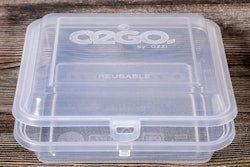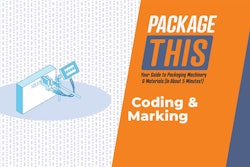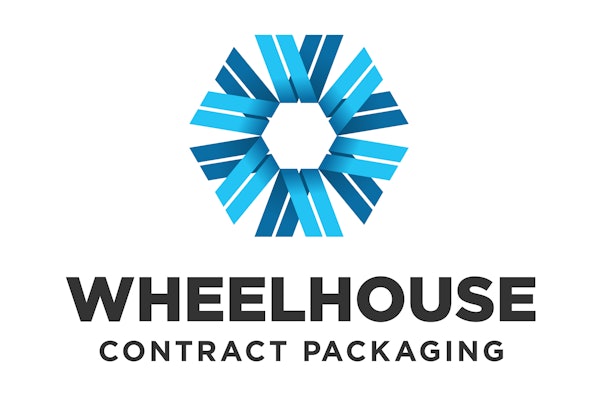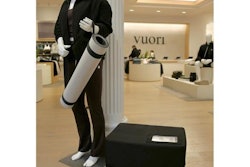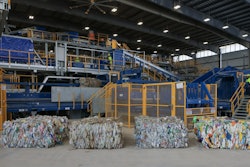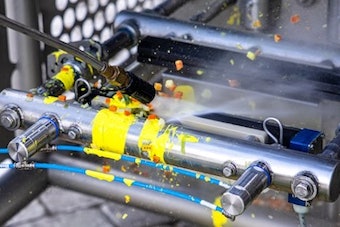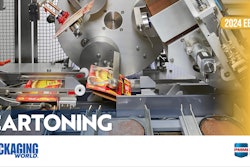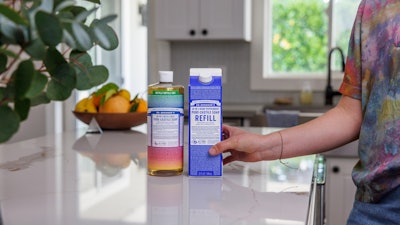
Dr. Bronner's is a CPG known both for its liquid soap products and for its status as an early adopter of environmentally friendly packaging practices. For years, the company had been bottling its liquid soaps in 100% post-consumer recycled (PCR) PET (rPET), an intentional step toward circularity that was ahead of its time.
That’s why the company took notice when, back in 2019, it discovered that more than half of its customer comments were related to plastic packaging use. It turned out that Dr. Bronner’s “hero product,” a 32-oz 100% rPET bottle, was responsible for the largest portion of its plastic footprint as a brand. Between low consumer recycling rates for plastic and an emerging consumer demand for non-plastic packaging options, Dr. Bronner's had to explore new solutions. Circumventing the single-use nature of its rPET soap bottles by refilling them with light paper cartons swam into view as an option.
“Feedback from consumers indicated a growing demand for non-plastic packaging options, prompting the company to seek alternatives that would align with its sustainability ethos and meet customer expectations,” Karina Tettero, packaging and printing production manager at Dr. Bronner’s, told Packaging World at SPC Impact in New Orleans last month. Karina Tettero, packaging and printing production manager at Dr. Bronner’s, spoke to Packaging World at SPC Impact in New Orleans last month.
Karina Tettero, packaging and printing production manager at Dr. Bronner’s, spoke to Packaging World at SPC Impact in New Orleans last month.
Adds Darcy Shiber-Knowles, director of operational sustainability & innovation at Dr. Bronner’s, “so, we decided that [32-oz bottle] was where we needed to focus our innovation. We explored different options for packaging types to replace our PCR PET bottle, and we performed a Life Cycle Assessment [LCA] to understand what would be the gentlest [on the environment] single-use container for our liquid soap.”
LCA informs format shift
The LCA revealed the answer to be a 32-oz paper-based gable-top refill carton with twist cap and closure, meant to refill existing 32-oz rPET bottles. The system achieved an 90% reduction in plastic compared to the 100% rPET bottles it’s meant to refill. Today, the 32-oz Pure-Castile Liquid Soap refill carton is made from 69% FSC-certified paper, 5% aluminum, and 26% polyethylene, with a polypropylene cap. The PE liner and aluminum are barriers that ensure shelf stability and prevent the soap from deteriorating the carton. Even as a multi-layer, multi-material structure that may or may not be recycled depending on the market, the paper-based carton was the clear choice. According to the LCA, this format had the lowest environmental footprint of all the options, which compared PCR, molded fiber, glass, aluminum, and paper cartons. The 32-oz Pure-Castile Liquid Soap refill carton is made from 69% FSC-certified paper, 5% aluminum, and 26% polyethylene, with a polypropylene cap. The PE liner and aluminum are barriers that ensure shelf stability and prevent the soap from deteriorating the carton.
The 32-oz Pure-Castile Liquid Soap refill carton is made from 69% FSC-certified paper, 5% aluminum, and 26% polyethylene, with a polypropylene cap. The PE liner and aluminum are barriers that ensure shelf stability and prevent the soap from deteriorating the carton.
Flexible packaging was not considered because the company “did not want to select a material made of virgin petroleum material that has zero end-of-life options for recycling or composting,” Shiber-Knowles says. “The carton is not plastic free, and it’s still single-use, but each carton is over 90% less plastic than its 32-oz PCR PET counterpart. And even if it goes to landfill, it has a lighter environmental impact than all the alternatives being recycled."
Wait a minute—if the cartons are indeed more sustainable, then why not replace the rPET bottles with cartons entirely? Because paperboard breaks down in water, and these soaps are meant to be used in the bathroom and shower.
“We clearly state these not to use this in a wet environment. All our information online and any ads we post on social media, and even on-pack messaging [more on that below] says, ‘please use this carton to refill an existing container.’ And this 100% PCR bottle will last you many, many years,” Tettero explained at the event.
Pilots and automation
The refill carton was initially piloted in select Whole Foods locations and on Dr. Bronner's website before being launched nationally at Target and Whole Foods, as well as online platforms like Amazon and Grove. Throughout these launches, Dr. Bronner's saw significant consumer interest and adoption of the new refill carton.
“It took a couple of years to move from choosing cartons to our market launch in July of 2023, as we needed to find a carton supplier [the supplier could not be named] that would partner with a cleaning product/body care company,” Shiber-Knowles explains. “Most carton suppliers prefer food and beverage customers, and we also needed to find retail partners to test this significant packaging change with us, design the education and communication about the change, and invest in equipment and staff in house. We also wanted to stress-test our LCA assumptions and ensure we were making the right choice.”
Today, the carton erecting, filling, and capping are fully automated. Dr. Bronner’s erects and fills the refill cartons on a NiMCO gable-top packaging line that at its headquarters in Vista, Calif.
On-pack messaging
Design firm Studio Jelly partnered with Dr. Bronner’s on the refill package’s artwork, look, and messaging. Each of the eight fragrances of Castile Liquid Soap has its own corresponding color for easy identification on the shelf. Perhaps more importantly, the package design also had to get the right messaging across to consumers who might not be used to refill systems.
“The messaging on the packaging is to educate consumers about this. We want folks to know that our refill carton contains the same wonderful liquid soap, just in more environmentally gentle packaging, which due to its paper-based nature cannot go in the shower like a plastic bottle could,” Shiber-Knowles says. “Simultaneously, we want to encourage refilling into the containers that folks already have, diluting, and using Dr. Bronner’s incredibly versatile Pure Castile Soap for many different cleaning uses. Most people already have containers in their homes—maybe even a Dr. Bronner’s bottle. The carton is our single-use package that reduces plastic, but it’s still single use. As we get used to refilling the containers we already have in our home, demand for circular and bulk delivery systems and retail experiences will increase and single use packaging of all types will decrease.”
An on-pack QR code takes curious consumers to the Dr. Bronner's website, which contains information about the cartons, about the LCA, about recycling, about the company's plastic reduction activity, and more.
According to the Carton Council, more than 60% of U.S. households have access to carton recycling in local programs, meaning cartons are able to carry the standard “Please Recycle” logo in accordance with the FTC’s green guides. But Dr. Bronner’s didn’t go that route.
“On our website and through consumer education platforms we share that if cartons are recyclable in your community, you can put this carton into your recycling bin, with the cap on. Keeping the cap on reduces leakage of plastic materials to our environment, even if the separated plastic ends up in landfill after the paper recycling process. We encourage consumers to check locally as recycling systems vary across the U.S. Unfortunately, there may not always be an end market for collected and separated cartons, which may affect whether a recycler will accept them. We do not want to mislead consumers or greenwash, so we do not put recyclability claims on our package,” Shiber-Knowles explains.
What’s next?
Dr. Bronner’s isn’t resting on its laurels with the newly launched refill carton project. For instance, the twist cap is currently made using virgin petroleum polypropylene. The company is evaluating alternative options and may switch to PCR or other materials to increase the sustainability of the sourcing or end-of-life options for the caps. Meanwhile, the plastics savings keeps growing with every purchase of a carton to refill the rPET bottle, and that savings could grow even faster if the refill format were extended to other product lines.
“For now, our Liquid Castile is the only product in cartons, but we are actively testing other products to see what else we can bring to market in this format that reduces plastic use. And it’s very encouraging that we are hearing from customers that they’d love it,” Shiber-Knowles says.
Since launching these cartons less than a year ago, Dr. Bronner’s says it has obviated more than 27,000 lbs of plastic, and is currently working to install another carton filling machine to keep up with increasing demand.
“We are so proud of our refill carton–and at the same time we also know that for the planet the best packaging is often no packaging at all. Nature itself is circular which inspires us. We hope eventually that consumer behavior will shift from single-use packaging toward a truly circular, refill-based consumption model,” Shiber-Knowles says. “In fact, we are currently piloting truly circular bulk refill stations for our liquid soaps at select retailers in California, and we hope to expand this program nation-wide over time. Our hope is that refill carton consumers join us along a journey toward zero waste; buying the carton is a fantastic step in reducing plastic use while still bringing our Castile Soap home, and the next step is refilling and reusing the containers that already exist.”
“And just seeing the response that we've gotten has been gigantic. So, it's really interesting to see that consumers even in the mass market are really ready to see this and to have this happen,” Tettero said at the event. “We're outpacing our PCR bottle two times now of what we normally would sell.” PW
